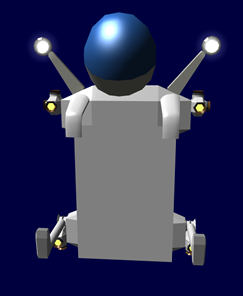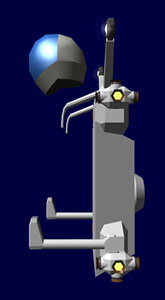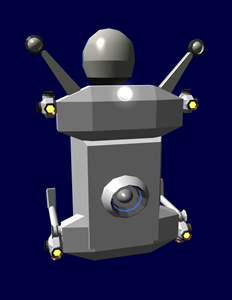Table of Contents
Star Army Void Propulsion Pack, Type 31
The Type 31 Void Propulsion Pack (VPP) is a thruster system for use with the Army Multi-Species Environmental Suit (AMES) it became available in YE 31.
Note: Helmet is not part of VPP, it is displayed to give reference for wearer's head location.
About the VPP
For military applications the AMES is fine as it is, because most of the ships have power armor that can be used to retrieve a crew member who gets separated from the ship. Civilian vessels do not have that backup. So the Type 30 VPP gives personnel performing Extra-vehicular activity (EVA) greater range, mobility and safety. It also helps them to perform more complicated tasks and even move large pieces of equipment.
History
The Scientific Studies Service (SSS) approached the Ketsurui Fleet Yards regarding making EVA safer for their personnel. Having many personnel traveling on their Tansaku-class Science Vessels, and more working on their Kisaki-class Starbases. SSS Personnel were needed to perform more EVA activities in the form of repairs, maintenance and such. The Type 31 VPP is the result of that request.
Appearance
The VPP looks like a back pack with numerous maneuvering thruster ports.
Putting on the VPP
Donning the VPP is fairly simple. It is put on much like a backpack except that its larger. There are two adjustable shoulder braces that the restraining straps extend from. Proper adjustment has the overthrust unit aligned with the small of the back as close to the center of gravity of the wearer. It fits over the AMES back pod.
Statistical data
General
Organization Using This item: Star Army of Yamatai, Scientific Studies Service (SSS), Other Civilian organizations Type: EVA Propulsion Nomenclature: Ke-G2-1a Designers: Ketsurui Zaibatsu Research and Development teams Manufacturers: Ketsurui Zaibatsu, Star Army of Yamatai, Scientific Studies Service (SSS) Entered service: YE 31 Price: 500 KS
Dimensions
Length: .5 meters ( 1.64 feet) Width: .7 meters ( 2.23 feet) Height: 1.4 meters ( 4.59 feet)
Propulsion and Range
VPP Maneuvering System
Maximum acceleration: .5m/sec²
Range: 7,200 seconds (120 minutes) of thrust at .5m
VPP Overthrust System
Maximum acceleration: 10 meters/sec² Emergency acceleration: 20 meters/sec² (Note: Fuel Consumption doubled)
Range: 300 seconds (5 minutes) of thrust at 10 meters/sec²
Components
Controls
The controls are on two folding arms that allow the user to manually guide the VPP. The user can also control the unit by verbal commands
Computer
The VPP uses an integrated computer that controls all aspects of the VPP. It monitors fuel consumption, and power. It operates the propulsion systems. It is interfaced through the controls or verbal commands. It is capable of interfacing into the AMES helmet system. Using the VPP's integrated sensors, the computer controls all movement using overthrust and station keeping.
Lighting Array
The lighting array of the VPP consists of two parts. The first is a pair of high intensity led lamps mounted on the top. They are mounted on rotating units to allow them to point where indicated. The user can direct the lights by verbal commands, such as “Pan right 5 degrees”, “Pan up 5 degrees.” The lights can move together or individually.
The other light is a strobe light mounted on the upper rear of the VPP. This serves as a safety feature allowing spotters to track the person.
Power
Nomenclature: Ke-G2-G3100 The VPP uses a capacitor system similiar to those found in the Ke-M2-G2701. They are recharged when the VPP is not in use and plugged into a standard power outlet. It is capable of power the VPP for 24 hours.
Propulsion
The VPP has two modes of propulsion. The primary is for maneuvering around, in small controlled movements. The secondary is to move the user over a greater distance.
Ke-G2-P3100 VPP Maneuvering System
This is the primary maneuvering system and consists of a series of sixteen thrusters located on the axial points of the unit. Each cluster of thrusters has four ports. This allows the VPP to execute, roll, pitch and yaw maneuvers. They are controlled by either two manual hand controls, or by the computer.
When the wearer is at their desired location, they can place the suit in station keeping mode. This means the VPP will keep the user at their current position, countering any movement caused by the wearers moving or actions.
The fuel for this is stored in the upper portion of the VPP. It is an inert fuel for the ion thrusters.
Ke-G2-P3101 VPP Overthrust System
The main thruster in this system is located in the back of the unit. This system is controlled by the computer. The user specifies a particular distance or a point to reach. When they engage the system, the computer engages the thruster, and controls pitch and yaw with the primary controls. The computer calculates the necessary speed and acceleration to execute the maneuver. At the appropriate point the unit with rotate the user 180 degrees and start deceleration.
Note: The VPP will not exceed the preset limits without an override code being entered.
The fuel for this is stored in the lower portion of the VPP. It is an inert fuel for the ion thruster.
Sensors
Laser range detector
Built into the bars that hold the lights are two laser range detectors. This allows the suit to calculate distance to an object. It also can calculate rate of closure.
Accuracy: +/- 10 cm Maximum Range: 5 km
Inertial Navigation System
The VPP uses a Inertial navigation system, consisting of gyroscopes, accelerometers. This is necessary for the Overthrust system to be used safely. It is also used when the VPP is put into station keeping mode.


